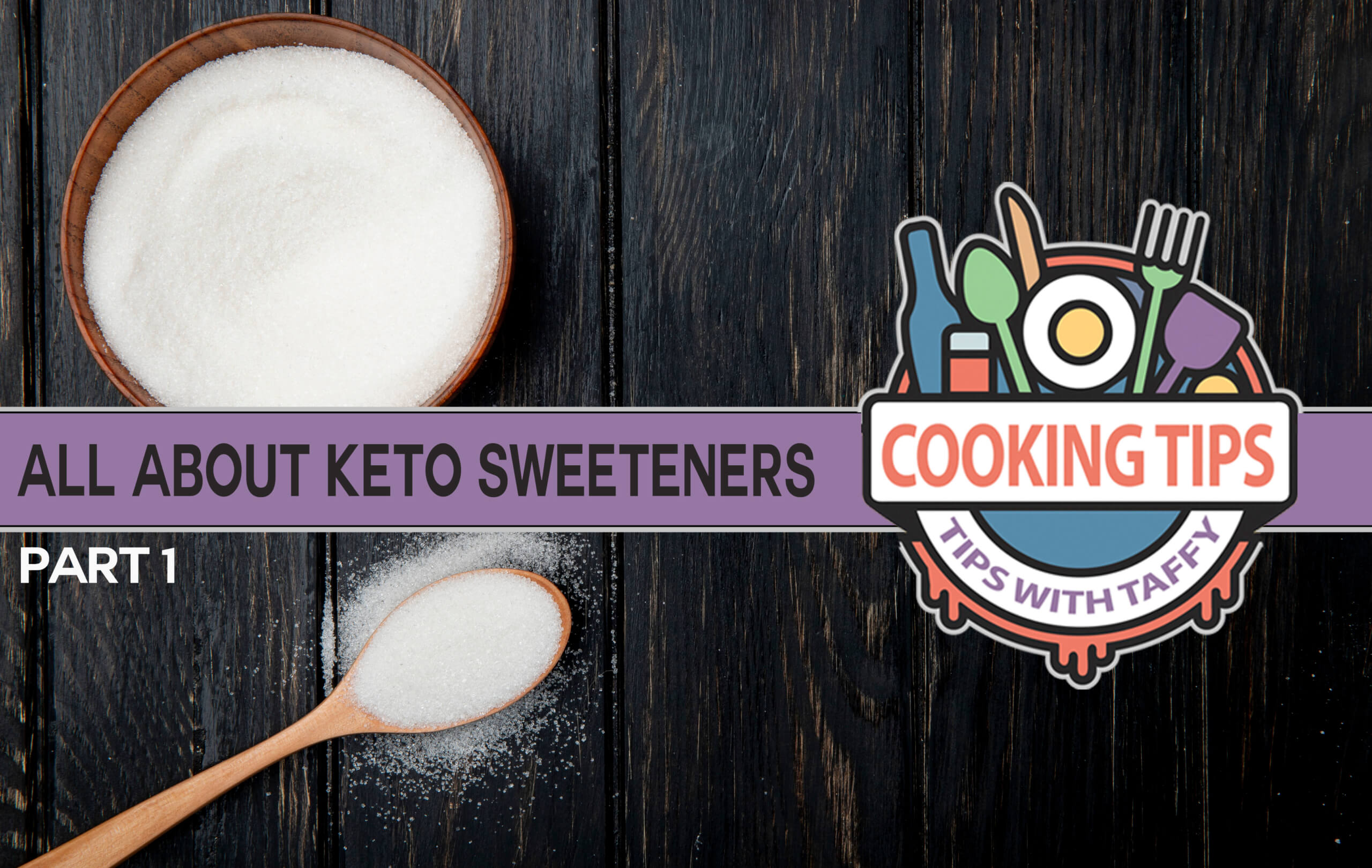Part 1: Granulated Sugar Replacers
Have you noticed how many keto-friendly sweeteners are available these days? It’s getting more and more complicated to sort them all out, let alone decide which one to use. But even though it seems as if there are dozens of sweeteners to choose from, most of the sugar-free sweeteners available are made from the same few ingredients. Once you know what those ingredients are and how they function in cooking and baking you can decide which ones you want to invest in.
I have also noticed that there doesn’t seem to be any standard for making the claim that a sweetener “tastes and cooks just like sugar” in fact as far as I can see almost all keto-friendly, granulated sweeteners make this claim. However, I have found that they vary widely in taste, texture, and results. I can’t say any of them taste or cook “exactly” like sugar but some of them do come close and when you combine different sweeteners for the result you want they can come very close to approximating sugar.
If you want to replace the sugar in something like a brownie, cookie, or ice cream, you have to account for more than the sweetness in the mixture. You have to replace the sugar by weight or volume as well because it can be up to 75% of the total weight or volume of the overall product. In cookies for instance sugar usually supplies 25 to 50% of the volume, and it contributes to the cookies’ distinctive traits such as crispness, browning and flavor. In ice creams sugar supplies some of the volume of the mix, but more importantly it contributes to the texture, binding water to keep the ice cream from freezing too hard.
Erythritol, xylitol, allulose and Bocha Sweet are granulated sweeteners that can be used to replace sugar in keyways. They deliver sweetness and they also deliver volume, body, and texture. They all have different levels of sweetness and different cooking qualities. It may take some experimenting to decide exactly what works for you but they can deliver excellent results when used with care.
- Erythritol is the work horse of the sugar-free world. It is a sugar alcohol that can be found granulated and powdered and is the carrying agent in most sweetener blends, like monk fruit and stevia blends. it’s inexpensive and it offers many uses. It does have a cooling effect as an aftertaste, and it doesn’t truly dissolve, so it recrystallizes after being cooked. This means it can add a crunchy texture to baked goods, which is great for things like biscotti, granola and brittles, but less good for custard-based pies, and creamy caramels. It’s mildly sweet and functions best with another sweetener like stevia or monk fruit to strengthen its sweetness.
- Xylitol is another sugar alcohol it has been in use for quite a long time. It is especially popular in chewing gums, candies, and dental products because it has a beneficial effect on dental health. It is considered a natural sweetener, it has a similar flavor to sugar, with no obviously detectable aftertaste. It can be used for most cooking and baking. It can be used to make ice creams that don’t freeze hard and custard based pies that stay soft. It is almost as sweet as sugar and can be used 1:1 in replacing sugar in recipes.
*Xylitol even in small amounts is dangerous for dogs so many people choose not to have it in the house at all.
- Allulose is a sweetener that is quite new to the market. It’s a naturally occurring “rare” sugar that can’t be metabolized by the body. It does bring many of the characteristics of sugar to baking and cooking which is very exciting. It is more costly than some other sweeteners, but you will get a lot of use out of it. I would say skip sweetening your coffee with it if you have another alternative for that and save the allulose for baking and making sweets when you want to impress. Allulose can caramelize first and foremost and makes ice cream scoopable and soft. It helps keep moisture in baked goods too. It does tend to brown quickly however so it can make baked goods look overdone, and it stays soft after cooking, so it doesn’t achieve a crunchy texture with it in things like brittles or crisp cookies.
*One caveat allulose can cause digestive distress so it’s a good idea to try it in small doses to begin with. Your digestion should adjust as you become accustomed to it, but it can be a steep learning curve.
- Bocha Sweet is a very new, still quite uncommon sweetener and in fact the only information I have found about it originates from the producer. As the name suggests bocha sweet is derived from kabocha squash and is considered a natural sweetener. It is still expensive but many people have reported enjoying the taste and texture which is similar very similar to table sugar. It has no aftertaste and few side effects. The good news it’s an easy 1:1 replacement for table sugar and has many of the qualities of sugar in cooking and baking, including keeping ice creams scoopable.
I have baked and cooked with all of these sweeteners to some degree but I thought it would be nice to apply some science and try a side by side comparison in a baking experiment and really see what kind of results I would get when I switched out just the sweeteners in a simple recipe that was otherwise identical, and in which the sweetener is obvious.
I made the classic three ingredient peanut butter cookies that I first learned to make in middle school:
1 cup peanut butter, 1 cup sugar, 1 large egg
I made a batch of cookies with each sweetener, unsweetened-creamy peanut butter, and standard eggs. I made all the cookies the same size with a #40 ice cream scoop and baked them all for 20 minutes at 350 degrees. I checked their flavor and consistency while warm, when cool and for two days after being baked. It was interesting to see so plainly how differently the sweeteners worked.
Below are my results
- Erythritol cookie – This cookie was soft, lightly brown, didn’t spread at all while baking, had a noticeable cooling effect, and hardened immediately as it cooled. After 12 hours it was rock hard and remained that way.
- Xylitol cookie – This cookie spread while baking like a sugar-based cookie, it browned slightly, it was quite sweet, it was soft and crumbly while cooling but after 12 hours became hard and shortbread like. It didn’t brown at all.
- Allulose cookie – This cookie didn’t spread at all but became brown quickly, it was moderately sweet, held together while cooking, had a more recognizable sweet, caramelized flavor, and was still tender after cooling and remained moist and tender 12 hours and beyond
- Bocha sweet cookie – this cookie was sweet, very soft, and crumbly, it spread like a sugar-based cookie, it remained soft as it cooled. It tasted good and would be hard to tell apart from table sugar by the taste alone. After 12 hours it became hard and crumbly like short bread. It didn’t brown at all.
Based on my experience with these cookies and my keto baking over the years, I suggest keeping at least two sweeteners to work with. Erythritol is less expensive, easy to source and has many uses, and when combined with another sweetener like allulose or Bocha Sweet you can create some impressive keto baked goods and sweets. From there, its up to you to experiment and see what you like the best.
Happy Cooking!









Any information on stevia? It’s referenced but not discussed.